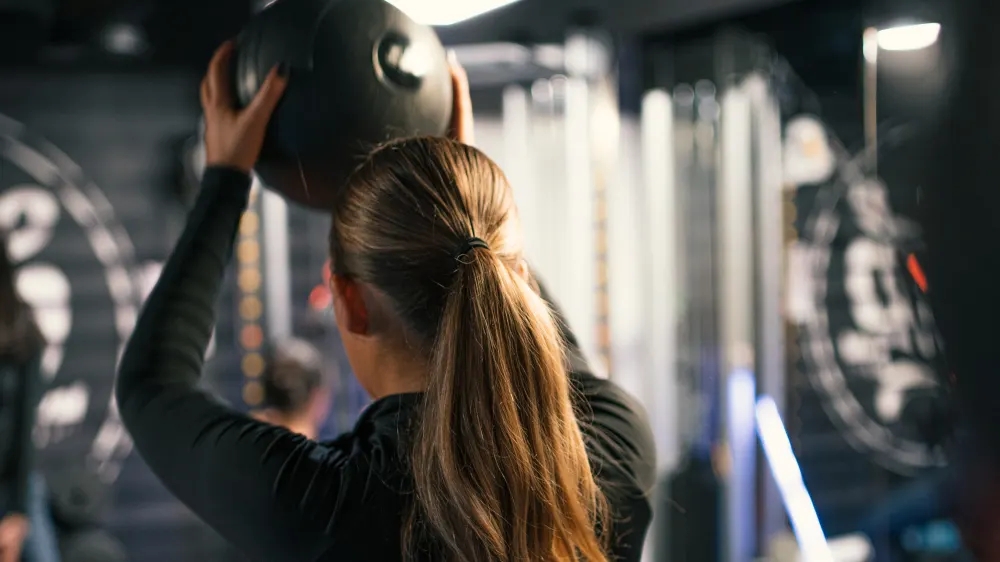2023 is the year of wellness. If you’re just starting out in the world of fitness, or are looking to level up your routine, you may be feeling a little stuck. That’s why we’ve enlisted the help of our fitness partner Stimulus. In this guest blog, they’re going to give you the facts on fitness and tell you about their honest opinions on TikTok fitness trends.

TikTok rose to fame for its viral sounds and dance routines. However, it has also exploded with exercises trends, which influencers claim, will help you reach your health and fitness goals quickly. While it’s great to have accessible fitness advice, the app can be full of disinformation around health. We think it’s time to debunk the myths and discover the facts about those trending TikToks. Are you being given genuine advice from a fitness professional? Or being sold a quick-fix dream from an influencer with no science to back up their claims?
We at Stimulus have trawled through the abundance of advice on TikTok, and pulled out all of the information worth knowing about:
Myth 1- “Spot reduction” exercises will help you to lose fat from a concentrated area of the body
Whilst spot reduction or losing weight from a specific area of the body such as the upper thigh, stomach or back of arms may be something on nearly everyone’s wish list, it unfortunately isn’t something that you can do. A lot of the exercises that are being recommended may certainly build muscle in those areas, if done with appropriate reps, sets and weight. However it will not guarantee a reduction of fat in that area.
To achieve fat loss, you need to be in a calorie deficit. That means that you use more calories throughout the day than you consume through eating and drinking. If you’re able to achieve this balance then your body will choose where that fat/weight loss will come from. This can be determined by genetics and your body’s natural composition. It’s not completely unachievable to lose fat from your desired area; it just means that your desired area may not be the first place you lose it from.

Myth 2- Do abs before bed
Abdominal exercises are great. They help build a strong core which is the foundation for a strong body, reducing risk of injury and helping you to achieve great fitness goals. However, the time of day at which you complete these exercises does not have an effect on how well you are able to build your abdominal muscles. Many TikTok influencers claim its best to work your abs before bed as you won’t be drinking or eating through the night, so it will work 10X better. Say goodnight to this advice, as this one is definitely a myth. Whilst it is true that you do not eat or drink during sleep, the only bearing this has on your abdominal area is that you are less bloated and your abs are therefore more visible.
If your goal is a washboard stomach or a rippling 6-pack, you’ve got to get your body fat down to a low enough level to make them visible. This is when that calorie deficit comes in again. Remember abs are made in the kitchen! So do your planks and crunches whenever you like.
Myth 3- Doing too much cardio will reduce your muscle mass
This one is a tricky one. Whether or not it is a myth all depends on your training and behaviours. Muscle Mass is the total amount of muscle in your body. This is made up of:
Skeletal Muscles- These exist throughout the body
Smooth Muscles- These are made up of your internal organs
Cardiac Muscles- The muscle of the heart
In order to build muscle mass you would need to partake in strength training and ensure you are consuming enough protein in your diet. If you include both of these in your training and behaviours then muscle mass is unlikely to be affected by cardio. Unless you are consuming less calories than you are using, on a daily basis. This is because our bodies need energy to perform exercise, which if not available in the body, will be taken from the muscles. This will result in a reduction in muscle mass. Back off on that strength training and you’re likely to see a reduction in muscle mass too.
So, as long as you eat right and keep up your strength training, then cardio will not affect your muscle mass, but it could support you in fat/weight loss.

Myth 4- The “12-3-20” Treadmill Challenge
This challenge promotes walking on a treadmill at an incline of 12% and a speed of 3 for 30 minutes, 5 times a week to lose weight. Walking on an incline will increase the intensity of the exercise, causing your heart and lungs to work harder, in turn using more energy. If you are in a calorie deficit, that will lead to weight loss. However, if you complete the “12-3-30” challenge 5 times a week and you eat more calories than you burn, then you will not lose weight.
Exercise prescription shouldn’t be a one size fits all approach. For a fit active person, these variables may be too easy, but to a sedentary individual, it could be really hard.
That incline could place additional stress on your lower leg muscles, which if repeated 5 days a week could lead to shin splints. Participating in a team sport or a fitness class 5 times a week would bring more fun to your workout and a social benefit too- without the shin splints!
Myth 5- Wearing waist trainers will result in a loss of stomach fat
The Kardashian-inspired craze is promoted by women aiming to sculpt their body, lose weight from their stomach and achieve a slimmer waistline. Unfortunately, these waist trainers do nothing permanent for losing stomach fat. Although, they can give the appearance of a shapelier figure when wearing them, the result does not remain when you take them off. Not to mention being super uncomfortable, they can actually alter the structure of your internal organs and make lasting changes internally.
How does breathing difficulties, rashes, infections, a weakened core and pelvic system and digestion issues sound? These are the risks that come with it. Steer clear of this one- it’s a dangerous myth.
Myth 6- The “75 hard” challenge
75 days of following a diet, working out twice a day for at least 45 minutes, drinking four litres of water a day, taking a 5-minute cold shower, and taking a progress picture every day. That’s the “75 hard” challenge. Could you fit that into your daily routine?
Whilst there’s nothing particularly wrong or dangerous about this one, it’s very broad in parts, high-reaching in others and seemingly hard to adhere to. The particular diet you should follow isn’t specified. Taking progress pictures every day is a bit excessive. Once a week would be more manageable and would show changes more readily. Working out twice a day is a great goal, but it’s unlikely that anyone could achieve that, especially for 75 days straight.
Drink the water, take cold showers if it helps with your mental health and track your progress with regular pictures. Exercise outside to get a bonus dose of vitamin D. Just make sure that the goals that you set yourself for your workouts and diet are realistic and achievable for you, which also means that they are sustainable in the long run.

Myth 7- Toning your muscles
For years workouts and exercises have been labelled ‘toning’ exercises. In reality ‘toning’ or ‘tone’ is a marketing term for muscle gain. The reason that it was termed as such is due to the fear of becoming ‘bulky’ by training with weights, particularly from females. So let’s call it what it is- toning is building muscle and that is achieved by progressive overload in strength training, by adding more weights or reps to a strength training routine. So be proud to lift that weight and celebrate your strength, whilst aiming for that definition in the process.
Myth 8 – No pain no gain
A good workout shouldn’t always mean a painful one. Pushing too hard in a workout, can lead to overtraining syndrome and can result in injury. During a workout you can measure the intensity through a scale called RPE- Rate of Perceived Exertion. With 1 being a reflection of easy and 10 being the hardest you could push yourself, you can pace your workouts to suit your goals.
Sometimes pain can be experienced after a workout. It’s important to give your muscles chance to recover properly. Pain in the muscles that you have targeted during your workout that occurs 24-48 hours after exercise is called DOMS- Delayed Onset of Muscle Soreness. This is a normal muscular response to exertion and is part of the adaption process by which the muscles recover as they undergo hypertrophy (an increase in muscle size).
If you’re new to exercise the best approach is to slowly build up to your goal.

Myth 9 – Fasted cardio
The concept of fasted cardio gained popularity when bodybuilder Bill Phillips featured it in his book ‘Body for life’. His argument was that you’ll burn more fat because your body is using stored fat instead of glucose for energy. The reality is that without a calorie deficit, it doesn’t matter. If you continually consume more calories than your body can use, then you will not burn fat. However, if you are eating fewer calories than your body uses then you will burn fat. Whether you perform cardio fasted or not, will have no bearing on the amount.
With all that said, if your preference is to exercise on an empty stomach to prevent discomfort, then there’s nothing wrong with that. If you’re pregnant, have blood pressure, blood sugar or medical issues you should consult your doctor or avoid doing it altogether.
How can we separate myth from fact?
Check your sources. Is the information being offered by a qualified Personal Trainer, Nutritionist or Sports and Exercise Professional? If it’s not, then they may not be qualified to offer fitness advice.
Get your information from more than one source. Whilst TikTok can offer engaging, bite-size information, you could also get that from a reputable website, a fitness page on social media or online fitness articles.
Trust your gut. If it seems too good to be true, it probably is.
Listen to the experts- speak to the Personal Trainers at your Vita Student gym, they’re always on hand to support you with specific fitness advice to suit your individual needs. They also deliver a range of fitness classes to help motivate you to achieve your goals, in the company of your friends.



